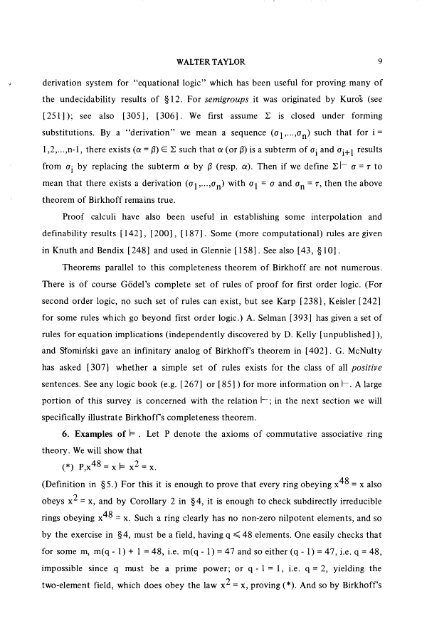Survey 1979: Equational Logic - Department of Mathematics ...
Survey 1979: Equational Logic - Department of Mathematics ...
Survey 1979: Equational Logic - Department of Mathematics ...
You also want an ePaper? Increase the reach of your titles
YUMPU automatically turns print PDFs into web optimized ePapers that Google loves.
WALTER TAYLOR 9<br />
derivation system for "equational logic" which has been useful for proving many <strong>of</strong><br />
the undecidability results <strong>of</strong> {}12. For semigroups it was originated by Kuro (see<br />
[251]); see also [3052, [306]. We first assume 2 is closed under forming<br />
substitutions. By a "derivation" we mean a sequence (o 1,...,on) such that for i =<br />
1,2,...,n-l, there exists (o =/3) C 2 such that o (or/3) is a subterm <strong>of</strong> o i and oi+ 1 results<br />
from o i by replacing the subterm a by /3 (resp. a). Then if we define 21- o = r to<br />
mean that there exists a derivation (o ! ,...,On) with o I = o and o n = r, then the above<br />
theorem <strong>of</strong> Birkh<strong>of</strong>f remains true.<br />
Pro<strong>of</strong> calculi have also been useful in establishing some interpolation and<br />
definability results [1422, [200], [187]. Some (more computational) rules are given<br />
in Knuth and Bendix [248] and used in Glennie [158]. See also [43, {} 102.<br />
Theorems parallel to this completeness theorem <strong>of</strong> Birkh<strong>of</strong>f are not numerous.<br />
There is <strong>of</strong> course G6del's complete set <strong>of</strong> rules <strong>of</strong> pro<strong>of</strong> for first order logic. (For<br />
second order logic, no such set <strong>of</strong> rules can exist, but see Karp [2382, Keisler [242]<br />
for some rules which go beyond first order logic.) A. Selman [393] has given a set <strong>of</strong><br />
rules for equation implications (independently discovered by D. Kelly [unpublished] ),<br />
and Sfomirski gave an infinitary analog <strong>of</strong> Birkh<strong>of</strong>f's theorem in [402]. G. McNulty<br />
has asked [3072 whether a simple set <strong>of</strong> rules exists for the class <strong>of</strong> all positive<br />
sentences. See any logic book (e.g. [267] or [85] ) for more information on I-. A large<br />
portion <strong>of</strong> this survey is concerned with the relation I-; in the next section we will<br />
specifically illustrate Birkh<strong>of</strong>f's completeness theorem.<br />
6. Examples <strong>of</strong> . Let P denote the axioms <strong>of</strong> commutative associative ring<br />
theory. We will show that<br />
(*) P,x 48=x x 2=x.<br />
(Definition in {}5.) For this it is enough to prove that every ring obeying x 48 = x also<br />
obeys x 2 = x, and by Corollary 2 in {}4, it is enough to check subdirectly irreducible<br />
rings obeying x 48 = x. Such a ring clearly has no non-zero nilpotent elements, and so<br />
by the exercise in {}4, must be a field, having q < 48 elements. One easily checks that<br />
for some m, m(q - 1) + 1 = 48, i.e. m(q - 1) = 47 and so either (q - 1) = 47, i.e. q = 48,<br />
impossible since q must be a prime power; or q-1 = 1, i.e. q= 2, yielding the<br />
two-element field, which does obey the law x 2 = x, proving (*). And so by Birkh<strong>of</strong>f's

















